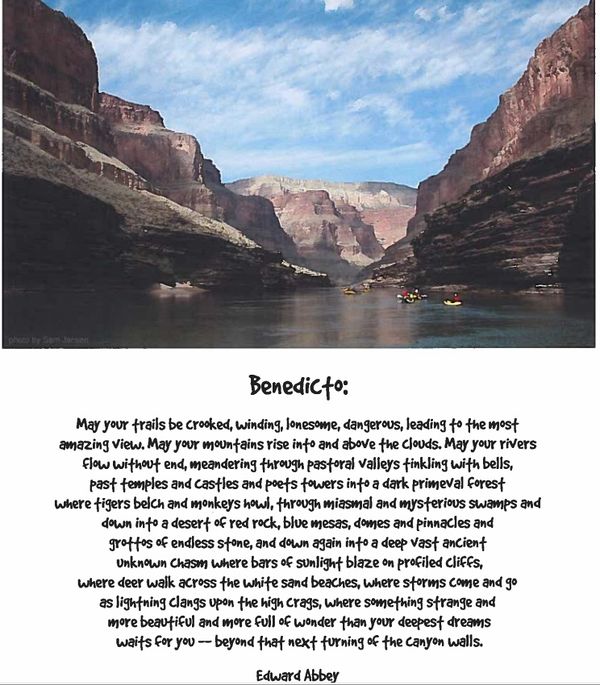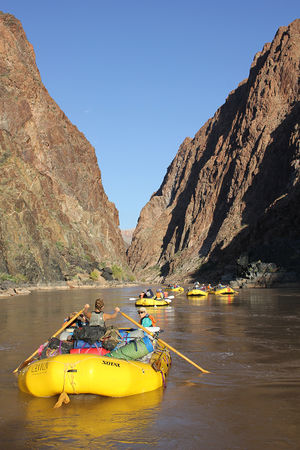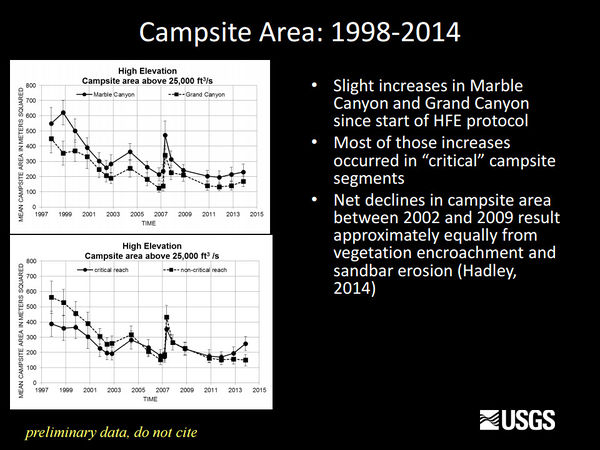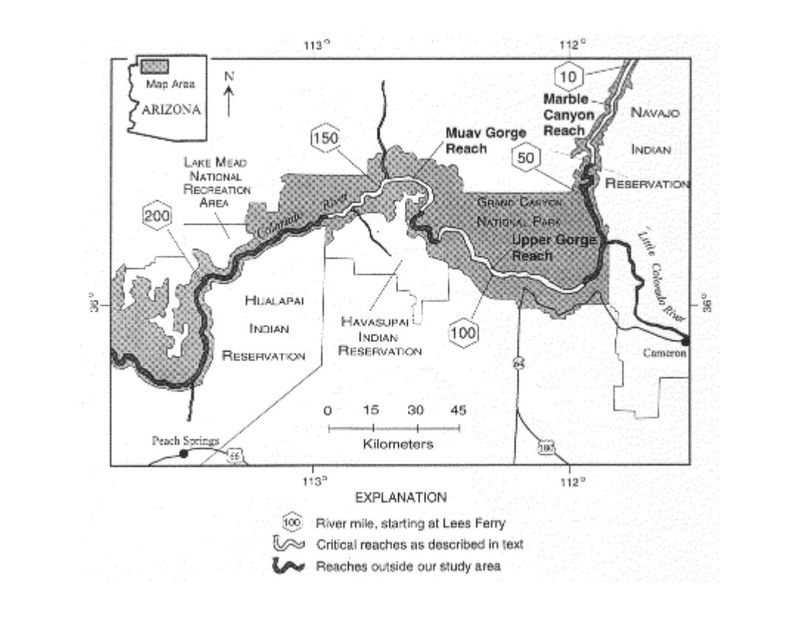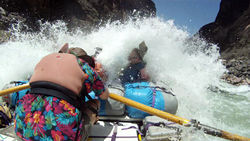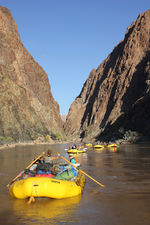Difference between revisions of "RECREATION"
Cellsworth (Talk | contribs) |
Cellsworth (Talk | contribs) |
||
| (14 intermediate revisions by the same user not shown) | |||
| Line 16: | Line 16: | ||
</tr> | </tr> | ||
</table> | </table> | ||
| − | |||
| − | |||
[[File:Benedicto- Poem- Edward Abbey- PIC.jpg |thumbnail|center|600px]] <br> | [[File:Benedicto- Poem- Edward Abbey- PIC.jpg |thumbnail|center|600px]] <br> | ||
| + | |||
| + | [[File:Granite Gorge- SJansen.JPG|thumbnail|center|300px]] | ||
<!-- | <!-- | ||
| Line 29: | Line 29: | ||
Sandbars have been used as campsites by river runners and hikers since the first expeditions to the region more than 100 years ago. Because the Colorado River is dominated by bedrock cliffs and steep talus slopes, sandbars provide unique areas along the river that are flat, relatively free of vegetation, easily accessible by river runners, and able to withstand high usage with negligible impact. These campsites continue to be an important part of the recreational experience for the more than 25,000 hikers and river runners that visit the Colorado River corridor each year. [https://www.gcmrc.gov/research_areas/sediment_geomorphology/sed/Sed_Geomorph_Camp.aspx] | Sandbars have been used as campsites by river runners and hikers since the first expeditions to the region more than 100 years ago. Because the Colorado River is dominated by bedrock cliffs and steep talus slopes, sandbars provide unique areas along the river that are flat, relatively free of vegetation, easily accessible by river runners, and able to withstand high usage with negligible impact. These campsites continue to be an important part of the recreational experience for the more than 25,000 hikers and river runners that visit the Colorado River corridor each year. [https://www.gcmrc.gov/research_areas/sediment_geomorphology/sed/Sed_Geomorph_Camp.aspx] | ||
| + | |||
| + | The motor season starts on April 1 and lasts through September 15. | ||
==[http://gcdamp.com/index.php?title=Long-term_Experimental_and_Management_Plan_(LTEMP) '''LTEMP Resource Goal for Recreational Experience''']== | ==[http://gcdamp.com/index.php?title=Long-term_Experimental_and_Management_Plan_(LTEMP) '''LTEMP Resource Goal for Recreational Experience''']== | ||
| Line 102: | Line 104: | ||
[[File:CriticalReaches.jpg|thumb|center|800px| [https://www.gcmrc.gov/library/reports/cultural/Recreation/01WRGR0007/AAB%202000.pdf Changes to Grand Canyon Camping Beaches, Year 2000: Annual Report of Repeat Photography by Grand Canyon River Guides, Inc. (Adopt-a-Beach Program)] ]] | [[File:CriticalReaches.jpg|thumb|center|800px| [https://www.gcmrc.gov/library/reports/cultural/Recreation/01WRGR0007/AAB%202000.pdf Changes to Grand Canyon Camping Beaches, Year 2000: Annual Report of Repeat Photography by Grand Canyon River Guides, Inc. (Adopt-a-Beach Program)] ]] | ||
| + | |||
| + | |- | ||
| + | ! <h2 style="margin:0; background:#cedff2; font-size:120%; font-weight:bold; border:1px solid #a3b0bf; text-align:left; color:#000; padding:0.2em 0.4em;"> What makes a beach campable? </h2> | ||
| + | |- | ||
| + | |style="color:#000;"| | ||
| + | |||
| + | *The threshold of 8 degrees is used to describe the approximate threshold for areas considered flat enough to use for camping (Kearsley and others, 1994; Hadley and others, 2018). | ||
|} | |} | ||
| Line 112: | Line 121: | ||
|style="color:#000;"| | |style="color:#000;"| | ||
| + | *[http://gcdamp.com/index.php?title=Portal:GCDAMP_Knowlege_Assessments GCMRC Annual Reports page] | ||
| + | *[https://www.nps.gov/grca/learn/management/upload/CRMPIF_s.pdf 2006 Colorado River Management Plan] | ||
*[http://gcpba.org/ Grand Canyon Private Boaters Association (GCPBA) Page] | *[http://gcpba.org/ Grand Canyon Private Boaters Association (GCPBA) Page] | ||
*[http://www.gcrg.org/index.php Grand Canyon River Guides (GCRG) Page ] | *[http://www.gcrg.org/index.php Grand Canyon River Guides (GCRG) Page ] | ||
| Line 120: | Line 131: | ||
*[http://gcdamp.com/index.php?title=Riparian_Vegetation Vegetation Page] | *[http://gcdamp.com/index.php?title=Riparian_Vegetation Vegetation Page] | ||
*[http://gcdamp.com/index.php?title=FISHERY The Lees Ferry Rainbow Trout Fishery Page] | *[http://gcdamp.com/index.php?title=FISHERY The Lees Ferry Rainbow Trout Fishery Page] | ||
| + | *[http://gcdamp.com/index.php?title=GCDAMP-_Over-Flights Over Flights Page] | ||
|- | |- | ||
| Line 149: | Line 161: | ||
|- | |- | ||
|style="color:#000;"| | |style="color:#000;"| | ||
| + | |||
| + | '''2024''' | ||
| + | *[[Media:DebrisFlowRisk_ARM_Poster_reviewed2.pdf | Debris flow risk at campsites in Grand Canyon]] | ||
| + | |||
| + | '''2023''' | ||
| + | *[https://www.usbr.gov/uc/progact/amp/twg/2023-01-26-twg-meeting/20230126-AnnualReportingMeeting-Assessing50yearsEcologicalChangesCampsitesColoradoRiverGrandCanyon-508-UCRO.pdf Assessing 50 years of ecological changes at campsites along the Colorado River in Grand Canyon] | ||
| + | |||
| + | '''2022''' | ||
| + | *[https://www.usbr.gov/uc/progact/amp/twg/2022-06-16-twg-meeting/20220616-AdoptABeach-508-UCRO.pdf Adopt-A-Beach ] | ||
| + | |||
| + | '''2021''' | ||
| + | *[https://www.usbr.gov/uc/progact/amp/amwg/2021-02-11-amwg-meeting/20210211-LifeNeedsRivers-Presentation-508-UCRO.pdf Life Needs Rivers ] | ||
| + | *[https://www.usbr.gov/uc/progact/amp/twg/2021-01-22-twg-meeting/20210122-AnnualReportingMeeting-ModelingToolsManagementRecreationGlenGrandCanyons-508-UCRO.pdf Modeling Tools for Management: Recreation in Glen and Grand Canyons ] | ||
| + | |||
| + | '''2020''' | ||
| + | *[https://www.usbr.gov/uc/progact/amp/twg/2020-06-24-twg-meeting/20200624-AdoptABeachPhotography.pdf The Adopt-A-Beach Repeat Photography Project ] | ||
| + | *[https://gcc02.safelinks.protection.outlook.com/?url=https%3A%2F%2Fwww.usgs.gov%2Fmission-areas%2Fecosystems%2Fscience%2Fusgs-ecosystems-podcast-series-outstanding-field%3Fqt-science_center_objects%3D0%23qt-science_center_objects&data=04%7C01%7C%7C0480a242627b46269d6308d87f5b43b8%7C31ae220fb94f463a9cfd15bbc9909df5%7C0%7C0%7C637399377259505498%7CUnknown%7CTWFpbGZsb3d8eyJWIjoiMC4wLjAwMDAiLCJQIjoiV2luMzIiLCJBTiI6Ik1haWwiLCJXVCI6Mn0%3D%7C1000&sdata=znP5xAcqaMCf9FPdLCvKxLdftJvFwhnagMPpf2%2BG2nQ%3D&reserved=0 Sandbars and vegetation in Grand Canyon—podcast] | ||
| + | *[https://www.usbr.gov/uc/progact/amp/twg/2020-01-13-twg-meeting/20200113-AnnualReportingMeeting-ChangesSandbarsCampsitesDuringHFEProtocol-Presentation-508-UCRO.pdf Changes in sandbars and campsites during the HFE Protocol ] | ||
'''2018''' | '''2018''' | ||
| Line 179: | Line 209: | ||
*[http://pubs.usgs.gov/sir/2010/5015/ Hazel et al. 2010. Sandbar response in Marble and Grand Canyons, Arizona, following the 2008 high-flow experiment on the Colorado River: U.S. Geological Survey Scientific Investigations Report 2010-5015, 52 p.] | *[http://pubs.usgs.gov/sir/2010/5015/ Hazel et al. 2010. Sandbar response in Marble and Grand Canyons, Arizona, following the 2008 high-flow experiment on the Colorado River: U.S. Geological Survey Scientific Investigations Report 2010-5015, 52 p.] | ||
*[http://pubs.usgs.gov/sir/2010/5135/ Kaplinskiet al. 2010. Colorado River campsite monitoring, 1998–2006, Grand Canyon National Park, Arizona, in Melis et al. eds., Proceedings of the Colorado River Basin Science and Resource Management Symposium, November 18-20, 2008, Scottsdale, Arizona: U.S. Geological Survey Scientific Investigations Report 2010-5135, 275-284 p.] | *[http://pubs.usgs.gov/sir/2010/5135/ Kaplinskiet al. 2010. Colorado River campsite monitoring, 1998–2006, Grand Canyon National Park, Arizona, in Melis et al. eds., Proceedings of the Colorado River Basin Science and Resource Management Symposium, November 18-20, 2008, Scottsdale, Arizona: U.S. Geological Survey Scientific Investigations Report 2010-5135, 275-284 p.] | ||
| + | |||
| + | '''1999''' | ||
| + | *[https://www.usbr.gov/uc/progact/amp/twg/1999-10-22-twg-meeting/Attach_12.pdf Behan, J. 1999, Recreation in the Colorado River Ecosystem, Grand Canyon, white paper to GCMRC] | ||
|- | |- | ||
Latest revision as of 17:21, 5 February 2024
|
|
Colorado River RecreationSandbars have been used as campsites by river runners and hikers since the first expeditions to the region more than 100 years ago. Because the Colorado River is dominated by bedrock cliffs and steep talus slopes, sandbars provide unique areas along the river that are flat, relatively free of vegetation, easily accessible by river runners, and able to withstand high usage with negligible impact. These campsites continue to be an important part of the recreational experience for the more than 25,000 hikers and river runners that visit the Colorado River corridor each year. [1] The motor season starts on April 1 and lasts through September 15. LTEMP Resource Goal for Recreational ExperienceMaintain and improve the quality of recreational experiences for the users of the Colorado River Ecosystem. Recreation includes, but is not limited to, flatwater and whitewater boating, river corridor camping, and angling in Glen Canyon. Desired Future Condition for for RecreationRiver Recreation in Grand Canyon National Park The Recreation DFCs are meant to describe goals and objectives for human use of the Colorado River Ecosystem (CRE) through GCNRA and the GCNP. They are intended to include not only traditional recreational activities such as whitewater rafting, camping, and fishing, but also such things as educational activities, spiritual engagement, and other appropriate activities and values. Grand Canyon and Glen Canyon offer many ways for people to experience, appreciate, and learn from them, even to those who never visit in person. |
| --- |
--- |
--- |
|---|
|
|
